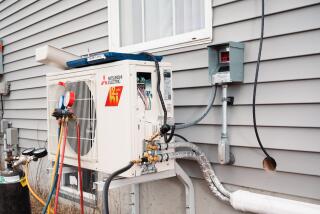Pluses, Minuses in Energy Use Since ’73
- Share via
Kuwait. Rarely does the mere mention of a country conjure a single image in our minds. Oil. The resource that has heated our buildings, fueled our cars, trucks and planes, fertilized our crops, controlled pests and brought us the plastic package--to mention but a few of its uses.
Until the more recent surge in environmental awareness, the role that energy plays in our daily lives was largely driven home by Middle East politics. Thankfully, recent events in that area of the world have not created an oil supply crisis.
In fact, Dick Watson, director of the Washington State Energy Office (WSEO), reports that refinery inventories are at or above normal levels. Clearly, however, these events have once again forced all of us to consider how much energy we use and what we would do if there were less of it than we have now.
Now is a good time to look at our energy use, how things have changed since that first oil embargo in 1973 and what you can do that will make your energy use more efficient. Though the current politics of energy heightens the sense of urgency, these recommendations would be just as sound and practical if Iraq had never invaded its neighbor.
Transportation
The trend for fuel efficiency in vehicles has only improved 1% per year. Our 1973, 13 mile per gallon (mpg) average is only up to 16 mpg. There have been models of cars with record breaking increases in this area, but as consumers we do not always choose this route.
Your energy saving action doesn’t have to be as drastic as a new car purchase though. Try planning your trips to combine errands. Or increase your fuel efficiency without spending a dime by checking your tire pressure once a month.
A research project conducted by Alabama Energy Extension found that 58% of vehicles had improperly inflated tires. Most were under-inflated, increasing roll resistance of the tire and decreasing miles per gallon. Their study showed that fuel efficiency could be increased by as much as 8% simply by tire inflation. A notable savings that could make a staggering decrease in gallons of gasoline consumed.
Home Efficiency
Many people feel that the contribution they can make by conserving energy in their homes is inconsequential compared to the energy use of industry or other areas.
However, a number of technological innovations--energy-efficient windows and furnaces--have lowered energy use. Buildings are being designed and built more efficiently. This became a reality through progressive builders and utilities, which encouraged the construction of more energy-efficient buildings.
This means choosing a long-term societal benefit, such as a more secure energy future, over a short-term benefit, such as a lower initial cost. It is not uncommon to find new homes whose energy consumption is 40% less than homes that were built before 1980.
Increased growth underscores the importance of choosing energy-efficient alternatives. The advent and improvement of energy codes for new buildings has increased the quality of our building stock as well. Finally, some actions taken for purely short-term self-interest have a longer-term benefit.
For example, one of the most immediate ways we can respond to an “energy crisis” is to set back the thermostat. This has become a matter of course for many of us, even without automatic thermostats.
Technological innovations have lowered new-house energy consumption. In 1973, there were few code requirements for minimum levels of insulation or draft sealing in new housing.
Window technology has replaced the single pane of glass with multiple panes. Some window products contain special energy savings gases between the panes, others have special surface treatments to reduce heat flow. Window frame materials have also become more resistant to heat transfer. In addition to tremendous energy improvements, these products improve comfort in the home.
The way new homes are heated has changed. Increasing numbers of new houses are being built with electric or natural gas heating systems instead of fuel oil. New technology has improved the efficiency of furnaces.
The advent of induced draft combustion, flame retention burners and electronic ignitions on current furnaces has raised efficiencies to between 80% to 90%, or more. This is compared to the average efficiencies of 70% to 75% for new furnaces in 1973. Heat pumps have shown similar advances in efficiency in both heating and cooling.
Older homes present different energy problems. Of course, if you are adding a room or replacing a heating system, it is an ideal time to choose energy-efficient equipment and features.
When you are repainting the exterior it’s a good time to blow in wall insulation. Before adding attic insulation, make sure all the air leakage points around plumbing stacks, wires and attic hatches are sealed to prevent warm air escaping into the attic.
Those of us who actually depend on oil to heat our homes can also make sure we have annual furnace tune-ups. At worst, we can save the cost of the tune-up and we would be using less oil as well. Simple maintenance such as cleaning filters makes it easier for the heat to get to you quickly. If you don’t have a flame retention burner, but your furnace is still in good shape, replacing the old burner can cut down how much oil you use.
Appliances
Home appliance use accounts for only a small part of our total household energy budget, but is on the rise compared to 20 years ago. Though most appliances don’t consume petroleum directly, by conserving all forms of energy, we become less dependent on energy resources that must be transported long distances at great expense.
Energy-conserving appliances were seldom available in the ‘60s and early ‘70s. Many manufacturers now produce energy-efficient models. Some electric and gas utilities encourage energy-efficient appliances with customer service programs. Energy Guide Labels assist consumers in choosing more efficient models.
The greatest potential for energy savings in this area is water heating. By taking simple steps, including choosing well-insulated tanks, lowering thermostat settings and using low-flow fixtures, energy savings can be substantial. Where appropriate, other technologies, including demand (or tankless) and solar water heaters can reduce energy use further for a moderate investment.
Refrigerators are another large energy-consuming appliance. The biggest opportunity for energy savings is when you buy a new one, since efficiency has been increased by as much as 50% over models from the early 1970s. For the unit you own, keeping the freezer defrosted and the condenser coils clean will improve it’s efficiency. Also be sure the door gasket provides a tight seal over the entire length.
Recycling
If you are wondering what recycling has to do with oil, consider the following. In the year 2000, according to an U.S. Environmental Protection Agency study, we will landfill or incinerate the following materials: 11.4 million tons of newsprint, 16.2 million tons of corrugated container board, 10.8 million tons of glass packaging, 8.2 million tons of plastic packaging, and 1.5 million tons on aluminum packaging.
If these 48.1 million tons were recycled instead, an energy savings equivalent to 10.1 billion gallons of gasoline--enough to fuel about 15.4 million cars for a year--would be available.
Studies repeatedly show that the products that are the most energy-intensive to make from virgin materials have the greatest potential for energy savings when recycled: Aluminum, 95% energy savings; plastics, 80% to 87%; newspaper, 34%.
Recycling saves energy because making new products from secondary, rather than virgin materials, is generally more efficient. This is because much of the processing (extracting and transporting the materials) has already been completed. With a national recycling level at 10%, we are wasting valuable sources of energy.
Your individual waste reduction efforts do make a difference. Let’s just take one area--packaging--which accounts for abut 40% of what you toss out. In 1989 alone, nearly 23 million barrels of oil were used for plastic packaging. That’s one month’s worth of U.S. oil imports from Iraq and Kuwait.
Be a selective shopper when you are at the grocery store. Buy products only in containers that can be recycled. Remember, if you can’t put the container in your curbside recycling bin or take it to a local recycler, it’s not recyclable.
Commercial
The commercial sector includes a wide variety of building types, including private and government offices, schools, hospitals, retail store, restaurants, hotels, apartment buildings and warehouses. Commercial buildings constructed since 1980 use 64% less fuel oil and 22% less natural gas than buildings built before 1980, according to a recent U.S. Department of Energy study of energy consumption in the commercial sector. Overall, commercial buildings have reduced consumption of fuel oil, on a gallon per square foot basis, by 34% since 1979.
These savings are the result of several factors. One area of improvement is building design. Features such as increased insulation and installation of more efficient windows, technical advances in the use of computerized energy management systems for temperature control and new energy-efficient mechanical systems for heating, cooling and ventilation reap big savings.
Building managers are able to operate buildings more efficiently by maintaining an ongoing preventive maintenance programs, keeping systems tuned to peak efficiency and turning off equipment when not in use. While energy-efficient components are important in reducing energy consumption, the most cost-effective method of reducing energy consumption and costs is by improving building operation and maintenance.
EASY WAYS TO SAVE CAR FUEL Here are some ways to increase fuel efficiency:
Repair or Maintenance Increase in Fuel Efficiency Correct Tune-up 4.7% Wheel Alignment .4% Brake Adjustments .5% Better Lubricants 2.0% Radial vs. Bias Tires 1.2% Correct Tire Inflation 2.5%
More to Read
Sign up for Essential California
The most important California stories and recommendations in your inbox every morning.
You may occasionally receive promotional content from the Los Angeles Times.













